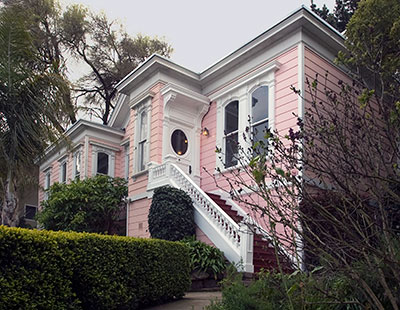San Francisco Landmarks
Miller-Joost House
3224 Market Street at 19th Street
Corona Heights
Built 1867
This vernacular house with Italianate influences is the oldest house on Twin Peaks. It is named after two German immigrants, Behrend Joost and Adam Miller whose daughter married Joost in 1874. The construction date is unknown, but the oldest part of the house may have been built as early as 1867 when Twin Peaks was farmland. As late as 1900, the area remained sparsely populated.
Joost had a diverse, sixty-year career as a successful San Francisco businessman. He constructed the first San Francisco electric street railway which brought service almost to this house. He founded a water company to distribute water from Twin Peaks sources to his neighborhood. His real estate investments helped build the San Francisco neighborhoods of Noe Valley, Bay View, Clarendon Heights and Sunnyside. He participated in the first attempt to dredge a canal across the Isthmus of Panama and had the wits to withdraw his profits before the initiative failed.
The freestanding house is situated on a bucolic half acre, a large lot by San Francisco standards, along with a guest cottage, wash house and potting shed. Originally, the land in front of the house sloped gently downhill, but the Market Street cut created a high retaining wall directly in front of the house, a wall which makes it easy to miss the house when walking or driving on Market Street.
When I updated this web page on 18 April 2009, the house was on the real estate market with an asking price of $2,5000,000.

The following article was published in the Glen Park News about a decade ago and is republished here with the kind permission of the author, Catherine G. Tripp.
THE JOOST BROTHERS LEADING THE PACK AND FIRST ON THE TRACK
Joost Avenue, which starts at the foot of Monterey Boulevard and ends at Hazelwood Avenue was named for Behrend and Isaac (or Tonges) Joost, and their electric trolley line centered in Glen Park. Their story begins in Saxony, Germany from which they emigrated in the 1840's. On December 25, 1915, a columnist known as "Old Timer", wrote in the San Francisco Observer the following description of Behrend's arrival: "I remember well that afternoon 'way back in '50 when a vessel from New York anchored in the harbor. Among the passengers was a lank young German, scarcely out of his teens. His hair and complexion strongly suggested a tinge of the gold that had lured him to the new El Dorado. His eyes rivaled the azure above us. While I was guessing who he might be, a man rushed from the crowd on the rude wharf and grabbed him in both arms. Tears moistened the eyes of both, and for fully a minute neither spoke. "Behrend!" "Tonges"!"
The brothers were very industrious in their new home, founding several grocery stores, and investing in real estate. According to one report, the Joost brothers purchased old Rancho San Miguel, a Mexican land grant encompassing ALL of Glen Park, Diamond Heights, Mount Davidson, Ingleside Terrace, Twin Peaks, and most of the Noe Valley, Ocean View, Forest Hill and the Outer Mission neighborhoods. The roughly 4,444 acre Rancho San Miguel was originally deeded to Jose de Jesus Noe1 in 1845, but Noe2 himself was forced to sell vast tracts of it soon after. It is not clear if their paths actually crossed, but the namesake of Noe Valley lived on his Rancho until 1862, so it is certainly possible.
The city's first opportunity to sample electric trolleys came in 1891 when two brothers, Behrend and Isaac Joost, organized The San Francisco and San Mateo Railroad Company. The central point of operations was at San Jose Avenue and 30th Street, and the car barn and pump house for storing water was located at the juncture of Baden Street and Circular Avenue. The line ran roughly from Steuart and Market streets to the line's terminus just beyond the Holy Cross cemetery. This prompted the Cypress Lawn Cemetery Association to successfully pressure the electric railway company to inaugurate funeral car service, inasmuch as the roads to the cemeteries were very poor and not conducive to safe and comfortable carriage traffic. In truth, this was the situation throughout the city at the time, and this new form of transportation was considered a godsend. Unfortunately, the Joost line did not pay expenses and was sold at a foreclosure sale on April 11, 1896. The final large consolidation of privately owned street railways in San Francisco came in 1902 when the San Francisco and San Mateo Electric Railroad, was purchased along with all the other major lines, forming the United Railroads of San Francisco. It does seem ironic that in 1891, the very first electric car service in San Francisco was able to go all the way to Colma - a feat our 20th century BART system struggled for decades to accomplish.
What became of the Joost brothers and their families has not yet surfaced, although I have heard that some relatives are living in Santa Rosa. The Old Timer's column closed with: "Still hale, hearty and cheery, his (Behrend Joost's) rugged face beams with the same old smile when he recounts incidents involving the careers of George Hearst, James Flood, Jim Fair, John W. Mackay, and all of the list of heroic men who wrote their names in letters of purple and gold".
Webmaster's footnotes:
1. NoeHill is located within the Rancho San Miguel land grant.
2. Noe rhymes with Chloe.
